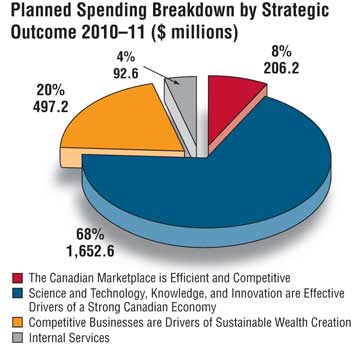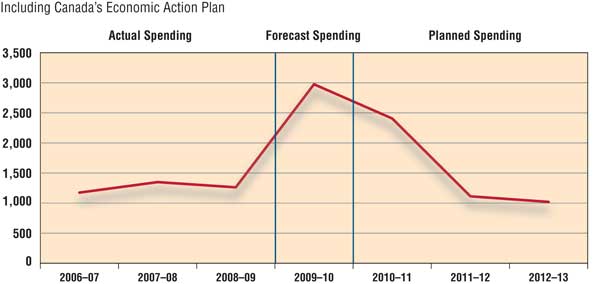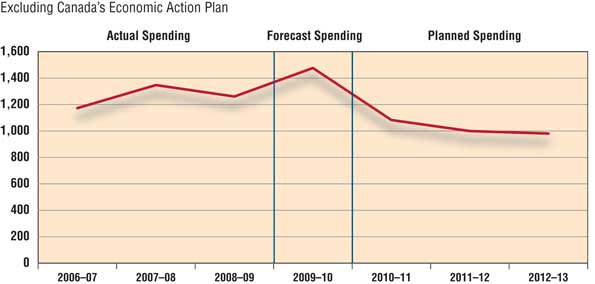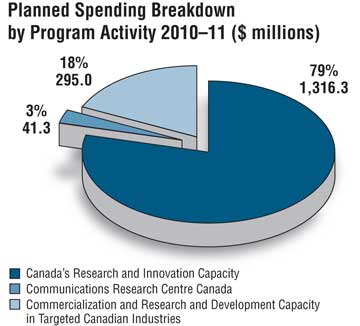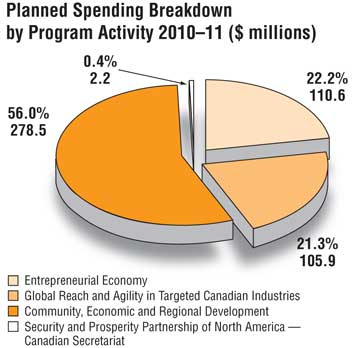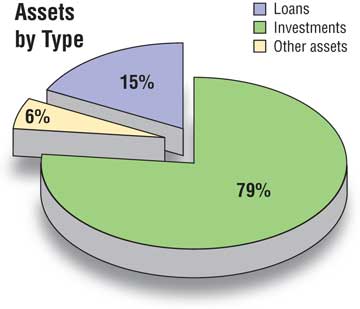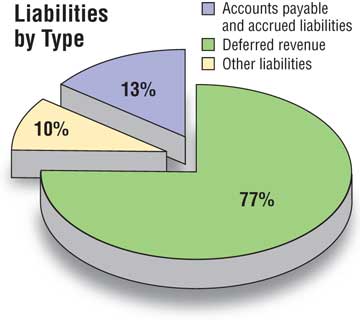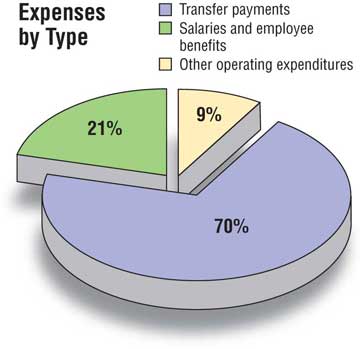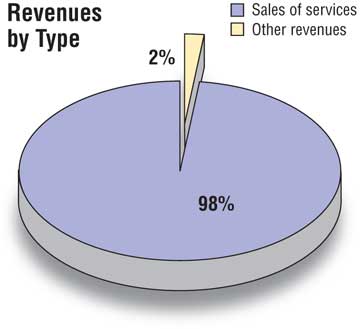ARCHIVED - Industry Canada
 This page has been archived.
This page has been archived.
Archived Content
Information identified as archived on the Web is for reference, research or recordkeeping purposes. It has not been altered or updated after the date of archiving. Web pages that are archived on the Web are not subject to the Government of Canada Web Standards. As per the Communications Policy of the Government of Canada, you can request alternate formats on the "Contact Us" page.
2010-11
Report on Plans and Priorities
Industry Canada
The original version was signed by
The Honourable Tony Clement
Minister of Industry
Table of Contents
Section 1: Departmental Overview
Section 2: Analysis of Program Activities by Strategic Outcome
- 2.2 Science and Technology, Knowledge, and Innovation are Effective Drivers of a Strong Canadian Economy
- 2.3 Competitive Businesses are Drivers of Sustainable Wealth Creation
- 2.4 Internal Services
Section 3: Supplementary Information

Minister's Message
Our government is committed to positioning Canada to exit the current downturn quickly and emerge stronger and more competitive in the global economy. In doing so, Industry Canada and its Portfolio partners will continue to play their key roles in increasing the country's capacity to create jobs and economic growth — for next year and for the next decade.
While the recession originated beyond our borders, it had real consequences for Canadians and Canadian business. And despite improving conditions, there is work to be done. In 2010, a major focus will be completing the stimulus measures of Canada's Economic Action Plan. Introduced in Budget 2009, the Plan's full effect will be felt in 2010–11, and its measures will help solidify the recovery.
Over this period, Industry Canada and its Portfolio partners will work with industries and sectors hit hardest by the recession. Initiatives will include activities to boost community economic development and to extend broadband infrastructure to underserved or unserved areas across the country. To build on the momentum gained through our past investments in science and technology, significant effort will be directed to shaping the knowledge-based economy.
Industry Canada will also focus on supporting business and industry to capitalize on emerging opportunities at home and abroad. Getting our economic frameworks right, through forward-looking policies, is central to ensuring Canada's place in the global marketplace. We remain committed to two-way trade and investment, which raises our capacity to create jobs and economic growth and provides for sustainable prosperity.
I will work with my colleagues, the private sector and other governments to advance the recovery and build the foundation for a strong, competitive economy.
It is my pleasure to present this year's Report on Plans and Priorities for Industry Canada and its Portfolio partners.
Tony Clement
Minister of Industry
Section 1: Departmental Overview
1.1 Raison d'être
Mission
Industry Canada's mission is to foster a growing, competitive, knowledge-based Canadian economy.
The Department works with Canadians throughout the economy, and in all parts of the country, to improve conditions for investment, improve Canada's innovation performance, increase Canada's share of global trade, and build an efficient and competitive marketplace.
Mandate
Industry Canada's mandate is to help make Canadian industry more productive and competitive in the global economy, thus improving the economic and social well-being of Canadians.
The many and varied activities Industry Canada carries out to deliver on its mandate are organized around three interdependent and mutually reinforcing strategic outcomes, each linked to a separate key strategy. The key strategies are shown in the illustration below.
 D
D  The Canadian marketplace is efficient
and competitive
The Canadian marketplace is efficient
and competitiveAdvancing the marketplace
Industry Canada fosters competitiveness by developing and administering economic framework policies that promote competition and innovation; support investment and entrepreneurial activity; and instill consumer, investor and business confidence.
 Science and technology, knowledge, and
innovation are effective drivers of a strong Canadian economy
Science and technology, knowledge, and
innovation are effective drivers of a strong Canadian economyFostering the knowledge-based economy
Industry Canada invests in science and technology to generate knowledge and equip Canadians with the skills and training they need to compete and prosper in the global, knowledge-based economy. These investments help ensure that discoveries and breakthroughs take place here in Canada and that Canadians realize the social and economic benefits.
 Competitive businesses are drivers of
sustainable wealth creation
Competitive businesses are drivers of
sustainable wealth creationSupporting business
Industry Canada encourages business innovation and productivity because businesses generate jobs and wealth creation. Promoting economic development in communities encourages the development of skills, ideas and opportunities across the country.
1.2 Responsibilities
Industry Canada is the Government of Canada's centre of microeconomic policy expertise. The Department's founding legislation, the Department of Industry Act, established the Ministry to foster a growing, competitive and knowledge-based Canadian economy.
Industry Canada is a department with many entities that have distinct mandates, with program activities that are widely diverse and highly dependent on partnerships. Industry Canada works on a broad range of matters related to industry and technology, trade and commerce, science, consumer affairs, corporations and corporate securities, competition and restraint of trade, weights and measures, bankruptcy and insolvency, intellectual property, investment, small business, and tourism.
1.3 Program Activity Architecture (PAA)
This Report on Plans and Priorities (RPP) is aligned with Industry Canada's Management, Resources and Results Structure (MRRS). The MRRS provides a standard basis for reporting to parliamentarians and Canadians on the alignment of resources, program activities and results.
Industry Canada's strategic outcomes are long-term, enduring benefits to the lives of Canadians that reflect our mandate and vision, and are linked to Government of Canada priorities and intended results.
The Department's Program Activity Architecture (PAA) is an inventory of all programs and activities undertaken. The programs and activities are depicted in a logical and hierarchical relationship to each other and to the strategic outcome to which they contribute. They also clearly link financial and non-financial resources.
2009–10 and 2010–11 PAA Crosswalk
Over the past year, Industry Canada has made changes to its PAA to ensure that it remains a complete and accurate inventory of Industry Canada's programs.
 Putting Research and Development Funding
Together
Putting Research and Development Funding
TogetherThe Knowledge Advantage in Targeted Canadian Industries and the Industrial Technologies Office — Special Operating Agency program activities have been merged into a new program activity named “Commercialization and Research and Development Capacity in Targeted Canadian Industries.” The program activities were merged because they had similar goals and used similar tools.
 Transferring Mackenzie Gas Project
Transferring Mackenzie Gas ProjectThe Mackenzie Gas Project Program Activity has been removed from Industry Canada's PAA to reflect its transfer to Environment Canada through an Order-in-Council (P.C. 2008-1730) on October 30, 2008.
 Creating/Removing Sub-Activities
Creating/Removing Sub-ActivitiesA number of new sub-activities were created to provide a more complete inventory of the Department's programs. They include the Ontario Potable Water Program, the Brantford Greenwich–Mohawk Remediation Project, the Canada Strategic Infrastructure Program, the Building Canada Program, the Internal Trade Secretariat, Innovation Capacity in the Automotive Industry, and Research and Development Capacity in the Aerospace Industry. Subsequently, the Eastern Ontario Development Program, the Canada-Ontario Municipal Rural Infrastructure Program, the Ontario Municipal Infrastructure Top-Up Program, the Ontario Potable Water Program, the Brantford Greenwich–Mohawk Remediation Project, the Canada Strategic Infrastructure Program, and the Building Canada Program were transferred to the newly created Federal Economic Development Agency for Southern Ontario during 2009–10 as a result of Budget 2009 and are therefore no longer the responsibility of Industry Canada.
The sub-activities under the “Global Reach and Agility in Targeted Canadian Industries” program activity have been restructured. They are now structured around what the programs do, rather than by industry as they were in the past.
The Canadian Youth Business Foundation (CYBF) sub-activity was merged with the Small Business Growth and Prosperity sub-activity, since foundations are not to appear in the PAA as per Treasury Board Secretariat (TBS) guidelines. While the achievement of results is the responsibility of the CYBF, Industry Canada is responsible for managing the related funding agreements and this activity is included in the Small Business Growth and Prosperity sub-activity.
 Changes to Program Titles and Descriptions
Changes to Program Titles and DescriptionsA number of programs were renamed, and a number of program descriptions were modified. The changes were made to reflect program changes or to improve compliance with the MRRS Instructions.
Industry Canada's 2010–11 Program Activity Architecture (approved by Treasury Board)
Strategic Outcomes |
||
|---|---|---|
| The Canadian Marketplace is Efficient and Competitive | Science and Technology, Knowledge, and Innovation are Effective Drivers of a Strong Canadian Economy | Competitive Businesses are Drivers of Sustainable Wealth Creation |
Program Activities |
||
| Marketplace Frameworks and Regulations | Canada's Research and Innovation Capacity | Entrepreneurial Economy |
Sub-Activities
|
Sub-Activities
|
Sub-Activities
|
| Marketplace Frameworks and Regulations for Spectrum, Telecommunications and the Online Economy | Communications Research Centre Canada | Global Reach and Agility in Targeted Canadian Industries |
Sub-Activities
|
Sub-Activities
|
Sub-Activities
|
| Consumer Affairs Program | Commercialization and Research and Development Capacity in Targeted Canadian Industries | Community, Economic and Regional Development |
Sub-Activities
|
||
| Competition Law Enforcement and Advocacy | Sub-Activities
|
Sub-Activities
Security and Prosperity Partnership of North America — Canadian Secretariat |
Sub-Activities
|
||
| Internal Services | ||
Industry Canada's 2010–11 Program Activity Architecture
(including Canada's Economic Action Plan initiatives)
Strategic Outcomes |
||
|---|---|---|
| The Canadian Marketplace is Efficient and Competitive | Science and Technology, Knowledge, and Innovation are Effective Drivers of a Strong Canadian Economy | Competitive Businesses are Drivers of Sustainable Wealth Creation |
Program Activities |
||
| Marketplace Frameworks and Regulations | Canada's Research and Innovation Capacity | Entrepreneurial Economy |
Sub-Activities
|
Sub-Activities | Sub-Activities
|
| Marketplace Frameworks and Regulations for Spectrum, Telecommunications and the Online Economy | Communications Research Centre Canada | Global Reach and Agility in Targeted Canadian Industries |
Sub-Activities
|
Sub-Activities
|
Sub-Activities
|
| Consumer Affairs Program | Commercialization and Research and Development Capacity in Targeted Canadian Industries | Community, Economic and Regional Development |
Sub-Activities
|
Sub-Activities
|
Sub-Activities
Security and Prosperity Partnership of North America — Canadian Secretariat |
| Competition Law Enforcement and Advocacy | ||
Sub-Activities
|
||
| Internal Services | ||
* Designates Economic Action Plan items
** Designates programs transferred to the Federal Economic Development Agency
for Southern Ontario
1.4 Planning Summary
Industry Canada's Financial and Human Resources
These two tables present Industry Canada's financial and human resources over the next three fiscal years.
| Financial Resources ($ millions)* | Human Resources (Full-Time Equivalent)*** | |||||
|---|---|---|---|---|---|---|
| 2010–11** | 2011–12 | 2012–13 | 2010–11 | 2011–12 | 2012–13 | |
| 2,448.6 | 1,151.2 | 1,058.6 | 5,279.0 | 5,176.0 | 5,176.0 | |
* Minor differences are due to rounding.
** The majority of funding for Canada's Economic Action Plan items ends in 2010–11.
*** Includes 112 FTEs for 2010–11
to deliver final year of Canada's Economic Action Plan
Summary Table by Strategic Outcome
Performance Indicator(s)
|
Target(s)
|
||||
| Program Activity | Forecast Spending 2009–10 | Planned Spending ($ millions)* | Alignment to Government of Canada Outcomes | ||
|---|---|---|---|---|---|
| 2010–11 | 2011–12 | 2012–13 | |||
| Marketplace Frameworks and Regulations | 59.5 | 66.1 | 68.4 | 63.9 | Economic Affairs: A Fair and Secure Marketplace |
| Marketplace Frameworks and Regulations for Spectrum, Telecommunications and the Online Economy | 91.1 | 87.2 | 86.4 | 85.6 | Economic Affairs: A Fair and Secure Marketplace |
| Consumer Affairs Program | 4.7 | 6.0 | 5.9 | 5.8 | Economic Affairs: A Fair and Secure Marketplace |
| Competition Law Enforcement and Advocacy | 47.5 | 46.7 | 48.1 | 49.5 | Economic Affairs: A Fair and Secure Marketplace |
| Total | 202.8 | 206.2 | 208.9 | 204.9 | |
* Minor differences are due to rounding.
Performance Indicator(s)
|
Target(s)
|
||||
| Program Activity | Forecast Spending 2009–10 | Planned Spending ($ millions)* | Alignment to Government of Canada Outcomes | ||
|---|---|---|---|---|---|
| 2010–11 | 2011–12 | 2012–13 | |||
| Canada's Research and Innovation Capacity | 1,281.1 | 1,316.3 | 252.9 | 170.3 | Economic Affairs: An Innovative and Knowledge-based Economy |
| Communications Research Centre Canada 1 | 44.6 | 41.3 | 38.1 | 37.4 | Economic Affairs: An Innovative and Knowledge-based Economy |
| Commercialization and Research and Development Capacity in Targeted Canadian Industries | 419.7 | 295.0 | 312.4 | 322.4 | Economic Affairs: An Innovative and Knowledge-based Economy |
| Total | 1,745.4 | 1,652.6 | 603.4 | 530.1 | |
* Minor differences are due to rounding.
Performance Indicator(s)
|
Target(s)
|
||||
| Program Activity | Forecast Spending 2009–10 | Planned Spending ($ millions)* | Alignment to Government of Canada Outcomes | ||
|---|---|---|---|---|---|
| 2010–11 | 2011–12 | 2012–13 | |||
| Entrepreneurial Economy | 138.4 | 110.6 | 104.1 | 114.2 | Economic Affairs: Strong Economic Growth |
| Global Reach and Agility in Targeted Canadian Industries | 192.0 | 105.9 | 36.7 | 36.7 | Economic Affairs: Strong Economic Growth |
| Community, Economic and Regional Development 2,3 | 549.2 | 278.5 | 106.0 | 80.6 | Economic Affairs: Strong Economic Growth |
| Security and Prosperity Partnership of North America — Canadian Secretariat | 2.2 | 2.2 | - | - | International Affairs: A Strong and Mutually Beneficial North American Partnership |
| Total | 881.8 | 497.2 | 246.8 | 231.5 | |
* Minor differences are due to rounding.
| Program Activity | Forecast Spending 2009–10 | Planned Spending ($ millions)* | Alignment to Government of Canada Outcomes | ||
|---|---|---|---|---|---|
| 2010–11 | 2011–12 | 2012–13 | |||
| Internal Services | 160.4 | 92.6 | 92.2 | 92.2 | Contributes to all of Industry Canada's strategic outcomes and therefore contributes to the Government of Canada's outcomes |
| Total | 160.4 | 92.6 | 92.2 | 92.2 | |
* Minor differences are due to rounding.
Contribution of Priorities to Strategic Outcomes
Operational Priorities
| Operational Priority: Ensure marketplace policies help promote competitive markets and instill consumer confidence |
Type: Previously committed to |
Strategic Outcome(s): The Canadian marketplace is efficient and competitive |
Why is this a priority?
|
||
| Operational Priority: Foster business innovation |
Type: Previously committed to |
Strategic Outcome(s): Science and technology, knowledge, and innovation are effective drivers of a strong Canadian economy |
Why is this a priority?
|
||
| Operational Priority: Invest in science and technology (S&T) to enhance the generation and commercialization of knowledge |
Type: Previously committed to |
Strategic Outcome(s): Science and technology, knowledge, and innovation are effective drivers of a strong Canadian economy |
Why is this a priority?
|
||
| Operational Priority: Foster internationally competitive businesses and industries |
Type: Ongoing |
Strategic Outcome(s): Competitive businesses are drivers of sustainable wealth creation |
Why is this a priority?
|
||
| Operational Priority: Promote entrepreneurship, community development and sustainable development |
Type: Ongoing |
Strategic Outcome(s): Competitive businesses are drivers of sustainable wealth creation |
Why is this a priority?
|
||
Management Priorities
| Management Priority: People Management |
Type: Ongoing |
Strategic Outcome(s): All strategic outcomes |
Why is this a priority?
|
||
| Management Priority: Financial Management |
Type: New |
Strategic Outcome(s): All strategic outcomes |
Why is this a priority?
|
||
| Management Priority: Internal Audit |
Type: New |
Strategic Outcome(s): All strategic outcomes |
Why is this a priority?
|
||
| Management Priority: Procurement and Materiel Management |
Type: New |
Strategic Outcome(s): All strategic outcomes |
Why is this a priority?
|
||
| Management Priority: Business Continuity |
Type: New |
Strategic Outcome(s): All strategic outcomes |
Why is this a priority?
|
||
Operating Environment and Risk Analysis
Industry Canada's work is influenced by a wide variety of external and internal factors. The programs and services the Department delivers are driven by the policies and priorities of the Government of Canada and must continually adapt to economic, social and technological trends. The Department, its partners and the businesses, investors and consumers it serves, operate within complex and interconnected global, national and regional economic systems that provide both opportunities and challenges. Industry Canada attempts to identify these opportunities and challenges through its planning process and through program and sector risk assessments. These factors, as well as the following key program challenges and opportunities, form Industry Canada's operating context and play a critical role in shaping the Department's plans and priorities.
Recent Economic Developments
Over the last year, the Canadian economy has suffered from the repercussions of the global economic downturn. The challenges in the global financial markets have led to a significant loss of wealth for Canadian consumers and businesses, hampering consumer confidence and dampening spending. Through various initiatives, Industry Canada will ensure Canadian industries have the opportunity to capitalize on the evolving economic climate as the sectors hit hardest by the recession — such as manufacturing — rebound. The Department will also continue to monitor the performance of the economy as a whole and will align its resources to increase the innovation, research and development capacity in targeted Canadian industries and priority areas, specifically those hardest hit by the recession.
Over the medium to long term, the Canadian economy will undergo significant changes as industries respond to new competition, demands for new goods and services, and evolving global markets. There is increasing pressure on Canadian businesses to adapt to changing global conditions, especially with respect to the effects of emerging economies on the global economic environment, the internationalization of supply chains and rapid developments in new technologies.
Industry Canada will continue to support the health of Canadian businesses and industries by helping them understand and exploit the changing global landscape. The Department will continue to support skills development, post-secondary education and sector-specific knowledge growth that, together, will help ensure that businesses have the tools they need to grow and prosper over the long term.
Consumer Interests
Economic instability, the globalization of supply chains and dramatic shifts in the technologies used to market and sell goods and services all affect Canadian consumers in numerous ways and present a major challenge for Industry Canada as it seeks to protect their interests.
With difficult economic conditions expected to continue in 2010–11, Industry Canada will likely face pressure to shift its activities towards a greater focus on the consumer basics of buying and saving. With its partners in provincial and territorial governments, the Department will need to identify and share the most cost-effective ways to increase compliance with consumer protection laws across the country, improve the consumer voice in policy-making and offer relevant consumer information.
Partner and Stakeholder Relations
Sound, productive relationships with partners and stakeholders are essential to fulfilling Industry Canada's mandate. The Department maintains close, collaborative relationships with, among others, federal departments, provincial, territorial and international governments, industry and consumer representatives, and academic and not-for-profit institutions. The increased opportunities and challenges created by the global economic situation will ensure that partnerships and stakeholder relations remain a key priority for the Department.
Integrated Risk Management
Industry Canada has implemented an effective and tailored Integrated Risk Management Framework that outlines the steps and approaches taken by the Department to identify, monitor and manage the key risks that can affect program delivery and results. In addition to the operating context and more specific challenges noted above, Industry Canada has developed mitigation strategies and action plans for its 2009–10 corporate risks (e.g., grants and contributions programs, information management, real property management framework, Canada's Economic Action Plan initiatives). Key risks and challenges associated with each strategic outcome are presented under the relevant section of this document.
Expenditure Profile
Industry Canada's total planned spending for 2010–11 is $2.4 billion. The majority of planned spending is directed at Industry Canada's three strategic outcomes, with a cost-effective 4% being allocated to Internal Services.
Industry Canada will continue to implement strategies to ensure efficient use of its operating budget to better deliver benefits to Canadians.
A focus on efficient, high-performing programs will allow Industry Canada to continue to effectively deliver its mandate with a reduced operating budget in coming years and with evolving government priorities. More than ever, the results of audits, evaluations and strategic reviews will be critical in planning, priority setting and resource allocation.
Canada's Economic Action Plan
In its 2009 budget, the Government of Canada announced Canada's Economic Action Plan, a set of initiatives aimed at providing a quick recovery from the economic downturn and ensuring long-term economic growth and prosperity for Canadian businesses and individuals. Industry Canada's role in Canada's Economic Action Plan has resulted in the Department's planned spending showing a dramatic temporary increase for 2009–10 of $1.5 billion. The Department expects to have a similar increase of $1.3 billion in 2010–11. A significant portion of those resources will be used to support science and technology, knowledge, and innovation, which, beyond providing short-term stimulus, will position the Canadian economy to excel in the future. This investment is made through initiatives such as the Knowledge Infrastructure Program, the Institute for Quantum Computing, the Canada Foundation for Innovation, and the modernization of Industry Canada's Communications Research Centre laboratory facilities. The Department will also promote economic recovery with initiatives aimed at specific economic sectors such as tourism, supporting small businesses and community economic development, and encouraging the development of broadband infrastructure in previously underserved or unserved areas across the country. Additional details on new Industry Canada initiatives emanating from Canada's Economic Action Plan are provided in Section 2 of this document.
Voted and Statutory Items
This table illustrates the way in which Parliament approved Industry Canada resources for 2009–10 and 2010–11.
| Vote No. or Statutory Item (S) | Truncated Vote or Statutory Wording | Main Estimates ($ thousands) * |
|
|---|---|---|---|
| 2009–10** | 2010–11 | ||
| 1 | Operating expenditures | 320,061 | 364,256 |
| 5 | Capital expenditures | 9,373 | 11,730 |
| 10 | Grants and contributions | 596,995 | 1,294,657 |
| (S) | Minister of Industry — salary and auto allowance | 78 | 79 |
| (S) | Minister of State (Small Business and Tourism) — auto allowance | 2 | |
| (S) | Minister of State (Science and Technology) — auto allowance | 2 | |
| (S) | Canadian Intellectual Property Office Revolving Fund | (1,203) | 13,659 |
| (S) | Liabilities under the Small Business Loans Act * | 1,650 | 125 |
| (S) | Liabilities under the Canada Small Business Financing Act * | 83,915 | 90,200 |
| (S) | Grant to CANARIE Inc. to operate and develop the next generation of Canada's Advanced Research Network (CAnet5) | 29,000 | 31,000 |
| (S) | Grant to GENOME | 88,800 | 43,000 |
| (S) | Grant to Perimeter | 10,000 | 10,000 |
| (S) | Contributions under the Knowledge Infrastructure Program | 500,000 | |
| (S) | Contributions to employee benefit plans | 49,374 | 53,998 |
| Total Budgetary | 1,188,043 | 2,412,708 | |
| L15 | Payments pursuant to subsection 14(2) of the Department of Industry Act | 300 | 300 |
| L20 | Payments pursuant to paragraph 14(1)(a) of the Department of Industry Act | 500 | 500 |
| Total Non-Budgetary | 800 | 800 | |
| Total Department | 1,188,843 | 2,413,508 | |
* Minor differences are due to rounding.
** Please note Budget 2009 funding for Canada's Economic Action Plan items
was allocated to the Department in Supplementary Estimates and is therefore not reflected in the amounts presented for 2009–10.
Spending Trend ($ millions)
The figures below illustrate Industry Canada's spending trend, including and excluding Canada's Economic Action Plan
items from 2006–07 to 2012–13.
1 Forecast and planned spending take into consideration the carry forward of funds of $253,000 from 2009–10 to future years ($176,000 in 2010–11, $56,000 in 2011–12 and $26,000 in 2012–13) for the Ivey Centre for Health Innovation and Leadership.
2 Forecast and planned spending take into consideration the carry forward of funds of $80 million from 2009–10 to 2010–11 for Broadband Canada: Connecting Rural Canadians.
3 Forecast spending excludes $22.5 million that represents the carry forward of funds of the Ontario Potable Water Program from 2009–10 to 2010–11. Please note that this program has been transferred to the new Federal Economic Development Agency for Southern Ontario in 2010–11.
Section 2: Analysis of Program Activities by Strategic Outcome
 2.1 The Canadian Marketplace is Efficient and Competitive
2.1 The Canadian Marketplace is Efficient and Competitive
| Year | Financial Resources ($ millions)* |
Human Resources (FTEs) |
|---|---|---|
| 2010–11 | 206.2 | 2,940.6 |
| 2011–12 | 208.9 | 2,940.6 |
| 2012–13 | 204.9 | 2,940.6 |
* Minor differences are due to rounding.
As the global economy emerges from a deep recession,4 the Canadian marketplace requires effective frameworks and regulations to ensure Canadian businesses have every opportunity to innovate and succeed in the new economic climate.
Strong marketplace frameworks and regulations are also necessary to facilitate competitiveness and to build and maintain consumer confidence in both traditional and electronic commerce environments.
Industry Canada strives to achieve an efficient and competitive marketplace by developing and implementing policies fundamental to the functioning of a market. These include laws and regulations governing intellectual property, bankruptcy and insolvency, competition and restraint of trade, corporations and corporate securities, foreign direct investment, internal trade, weights and measures, consumer affairs, and telecommunications.
These policies are designed to promote innovation, competition and productivity, and instill business, investor and consumer confidence.
Industry Canada further contributes to an efficient and competitive Canadian marketplace by:
- delivering regulatory regimes through regulations, policies, procedures and standards for bankruptcy; foreign direct investment; federal incorporations; intellectual property; and weights and measures;
- developing domestic regulations, policies, procedures and standards that govern Canada's spectrum and telecommunications industries and the online economy;
- ensuring that consumers have a voice in the development of government policies and are effective marketplace participants; and
- administering and enforcing the Competition Act, the Consumer Packaging and Labelling Act, the Textile Labelling Act, the Weights and Measures Act, the Electricity and Gas Inspection Act, the Bankruptcy and Insolvency Act, the Canada Business Corporations Act, the Investment Canada Act and the Precious Metals Marking Act.
In the coming years, key priorities include:
- encouraging Canadians and non-Canadians to invest in Canada and contribute to economic growth and employment opportunities;
- developing policy tools to protect the online marketplace and promote the digital economy in the areas of authentication, cryptography and identity management;
- developing regulations to bring into force the new Canada Not-For-Profit Corporations Act;
- managing the implementation of the Canadian Radio-television and Telecommunications Commission (CRTC) framework for the conversion of the over-the-air TV to digital;
- promoting Canadian views and defending Canadian interests in international organizations on next-generation networks, cybersecurity, emergency telecom services and conformity assessment;
- minimizing the administrative cost and paperwork burden of regulatory compliance on small businesses; and
- advocating in favour of market forces.
Focusing on these priorities will help protect Canadian consumers and improve the Canadian business environment.
Challenges and Risk Areas:
The constant evolution of the global business environment, combined with the impact of rapidly changing technologies and increasing client demands, reinforces the importance of developing credible and timely strategies that promote competitive growth while meeting consumer and business needs in a recovering economy.
| Human Resources (FTEs) and Planned Spending ($ millions)* | |||||
|---|---|---|---|---|---|
| 2010–11 | 2011–12 | 2012–13 | |||
| FTEs | Planned Spending | FTEs | Planned Spending | FTEs | Planned Spending |
| 1,779.6 | 66.1 | 1,779.6 | 68.4 | 1,779.6 | 63.9 |
* Minor differences are due to rounding.
| Expected Result | Indicators | Targets | |||
|---|---|---|---|---|---|
| Marketplace fairness, integrity, efficiency and competitiveness are protected in the areas of insolvency, foreign investment, weights and measures, federal incorporation, and intellectual property | Percentage of cases for which regulatory timelines and/or service standards are met | 80% |
Planning Highlights and Benefits for Canadians:
Industry Canada will implement the legislative amendments reflected in Chapters 36 and 47 of the Statutes of Canada under the Companies' Creditors Arrangement Act. These new amendments will ensure integrity and accountability in all areas of insolvency in Canada, and will further enhance the status of Canada's insolvency system both at home and abroad.
Following changes made to the Investment Canada Act, Industry Canada will, in 2010–11, improve the transparency and accountability of the foreign investment review framework in Canada by producing its first Annual Report.
Industry Canada will develop regulations and seek approval of user fees to bring into force the Canada Not-for-Profit Corporations Act, which establishes a modern governance framework for not-for-profit corporations.
In response to stakeholder requests that NUANS 5 become the single comprehensive source of corporate names used in all Canadian federal, provincial and territorial jurisdictions, Industry Canada will strive in 2010–11 to ensure that Canadians and Canadian businesses benefit from marketplace efficiency by engaging non-participating jurisdictions on the usage of NUANS, and, in the case of Quebec, on the provision of its data to NUANS.
Industry Canada will promote the effective use of intellectual property (IP) assets and information to Canadian small and medium-sized enterprises and the education sector.
By improving marketplace conditions through these actions, Industry Canada will ensure that Canadians and Canadian businesses benefit from cutting-edge marketplace fairness, integrity, efficiency and competitiveness.
| Human Resources (FTEs) and Planned Spending ($ millions)* | |||||
|---|---|---|---|---|---|
| 2010–2011 | 2011–12 | 2012–13 | |||
| FTEs | Planned Spending | FTEs | Planned Spending | FTEs | Planned Spending |
| 686 | 87.2 | 686 | 86.4 | 686 | 85.6 |
* Minor differences are due to rounding.
| Expected Result | Indicators | Targets | |||
|---|---|---|---|---|---|
| Canada's radiocommunications and telecommunications infrastructure and the online economy are governed by a modern, efficient and effective policy and regulatory framework | Percentage of policies, legislation and regulations developed, updated or reviewed and consultations conducted as identified in annual business plans/strategic plans/operational plans | 80% of identified initiatives |
Planning Highlights and Benefits for Canadians:
Canada's radiocommunications and telecommunications infrastructure and the online economy require modern, efficient and effective policy and regulatory frameworks. There is growing demand for advanced wireless services driven by an expanding mobility market and broadband Internet access. Industry Canada will undertake several priority actions to develop the policies, regulations, standards and treaties that will support effective spectrum management and the provision of new wireless services.
The Department will manage the technical aspects of the implementation of the Canadian Radio-television and Telecommunications (CRTC) framework for the conversion of the over-the-air TV signal to a digital TV signal. When the conversion is completed, it will allow auctioning of the 700 MHz spectrum and allow broadcasters to bring high-definition television (HDTV) to the viewing public across Canada.
Consultation processes will take place in preparation for auctions in both the 2500 MHz and 700 MHz bands. Auctioning of these bands will help support new mobile technologies and services in the Canadian marketplace.
Industry Canada is establishing the Electronic Commerce Protection Act (ECPA) to help protect the online marketplace by deterring the most damaging and deceptive forms of spam and other related online threats from occurring in Canada. As well, the Personal Information Protection and Electronic Documents Act (PIPEDA) legislation will be updated to enhance the protection of personal information as well as consumer and business confidence in the online marketplace.
The Department is exploring options for a digital economy strategy to boost Canada's productivity performance by focusing on the objectives of strengthening Canada's domestic information and communications technologies (ICT) sector, and increasing rates of business ICT adoption and use. The digital economy is an economic enabler and thus critical to Canada's future prosperity.
By delivering on these priorities, Industry Canada will ensure that policies and regulations are in place to protect Canadians and their increasing use of radiocommunications, telecommunications and ICT. It is expected that increasing the rates of use of these technologies will boost Canada's future prosperity.
| Human Resources (FTEs) and Planned Spending ($ millions)* | |||||
|---|---|---|---|---|---|
| 2010–11 | 2011–12 | 2012–13 | |||
| FTEs | Planned Spending | FTEs | Planned Spending | FTEs | Planned Spending |
| 23 | 6.0 | 23 | 5.9 | 23 | 5.8 |
* Minor differences are due to rounding.
| Expected Result | Indicators | Targets | |||
|---|---|---|---|---|---|
| Consumer interests are represented in the marketplace and in the development of government policies | Number of new outreach initiatives to assist consumers in accessing information and tools that will help them make informed purchasing decisions | 1 | |||
| Number of government policies and/or legislation developed, updated or reviewed by OCA | 2 |
Planning Highlights and Benefits for Canadians:
The challenges that face consumers and families in the current economic climate are growing. Addressing these challenges is essential to maintaining consumer trust and confidence in the marketplace. Industry Canada, through the Office of Consumer Affairs (OCA), will support consumers by focusing on areas where they may be particularly vulnerable, and by equipping them with tools they can use to help them spend wisely, thus contributing to a marketplace that is more efficient and competitive.
In conjunction with the Consumer Measures Committee (CMC), Industry Canada will explore measures to protect consumer interests through the joint analysis of current consumer pressures in priority sectors, and by sharing best practices in regulatory compliance with federal, provincial and territorial consumer protection laws.
The Department will further develop its consumer information tools, including the joint federal-provincial-territorial site Consumerinformation.ca and the Canadian Consumer Handbook, to help consumers meet the challenges posed by current economic conditions.
Industry Canada will work with partners in other departments and internationally on a variety of consumer policy projects pertaining to sustainable consumption, consumer vulnerability and electronic commerce.
Through these actions, Canadian consumers' interests will be better protected and Canadians will be able to make more informed decisions.
| Human Resources (FTEs) and Planned Spending ($ millions)* | |||||
|---|---|---|---|---|---|
| 2010–11 | 2011–12 | 2012–13 | |||
| FTEs | Planned Spending | FTEs | Planned Spending | FTEs | Planned Spending |
| 452 | 46.7 | 452 | 48.1 | 452 | 49.5 |
* Minor differences are due to rounding.
| Expected Result | Indicators | Targets | |||
|---|---|---|---|---|---|
| Competitive markets and informed consumer choice | Dollar savings to consumers from Bureau actions that stop anti-competitive activity | $330 million | |||
| Percentage of economy subject to market forces | 82% of GDP |
Planning Highlights and Benefits for Canadians:
In 2010–11, the Competition Bureau will continue to focus its efforts on the effective implementation of the amendments made to the Competition Act on March 12, 2009. The Bureau will also clarify key enforcement issues in the areas of abuse of dominance, competitor collaborations and price maintenance, to ensure increased transparency, clarity and predictability for all Canadians.
The Bureau will continue to focus its enforcement efforts on domestic bid rigging, abuse of dominance, and timely and effective merger reviews.
As well, as part of its ongoing effort to ensure that Canadians know how to better protect themselves from fraudulent claims, to better recognize scams and to avoid falling victim to such scams, the Bureau will target Mass Marketing Fraud (MMF) over the Internet.
The Bureau will continue to advocate for greater reliance on competition and will work with federal and provincial governments, where appropriate, on strategies that address market inefficiencies to further strengthen the Canadian marketplace.
The Bureau, as a law enforcement agency, contributes to the prosperity of Canadians by protecting and promoting competitive markets in which efficiencies and innovation are fostered, and where consumers can make informed choices.
 2.2 Science
and Technology, Knowledge, and Innovation are Effective Drivers of a Strong Canadian Economy
2.2 Science
and Technology, Knowledge, and Innovation are Effective Drivers of a Strong Canadian Economy
| Year | Financial Resources ($ millions)* |
Human Resources (FTEs) |
|---|---|---|
| 2010–11 | 1,652.6 | 747.5 |
| 2011–12 | 603.4 | 731.5 |
| 2012–13 | 530.1 | 732.5 |
* Minor differences are due to rounding.
Strategic science and technology (S&T) investments are key drivers in rebuilding the post-recession Canadian economy.
Fostering innovation and commercialization of new technologies is fundamental to improving Canada's overall productivity and enhancing Canada's competitiveness on a global scale during the economic recovery.
In support of this objective, Industry Canada advances leading-edge research and development (R&D) and provides value-added knowledge and expertise to enhance conditions for commercialization and innovation in targeted Canadian industries. The Department works with the private sector, industry associations, academia and all levels of government to foster an environment that is conducive to innovation and that promotes scientific excellence and industrial competitiveness.
These collaborative relationships advance technology transfer, spinoffs and innovation; contribute to a skilled workforce; and ensure that Canadians and Canadian businesses benefit from an innovative and knowledge-based economy.
Industry Canada further contributes to a strong Canadian economy driven by science and technology (S&T), knowledge and innovation by:
- sustaining knowledge and talent through world-class leadership in S&T policies and programs;
- promoting a business environment that supports excellence in innovation;
- contributing to strategic, large-scale R&D projects in the automotive sector that support innovative, greener and more fuel-efficient vehicles; and
- conducting research on advanced telecommunications and information technologies to support the development of new products and services for the ICT sector.
In the coming years, key priorities include:
- providing science policy advice and policy frameworks to fulfill commitments made in Mobilizing Science and Technology to Canada's Advantage, Canada's S&T strategy;
- producing the 2010 state of the nation report on Canada's science, technology and innovation system;
- working with partners to enhance the global competitiveness of Canada's health industries by encouraging the commercialization of biotechnology;
- continuing to collaborate with partners to enhance Canada's competitive advantage in hydrogen and fuel cell technology development and commercialization;
- encouraging and promoting the adoption and adaptation of new technologies and skills to business processes; and
- working with portfolio agencies to develop funding programs that promote R&D within Canadian industries.
Focusing on these priorities will spur innovation and ensure that Canadian businesses become increasingly competitive and successful.
Challenges and Risk Areas:
The current global and financial context, as well as shifting economic drivers, may impact the investment and innovation capacity of Canadian industries and their ability to leverage leading-edge research and S&T discoveries.
Canada's Economic Action Plan:
On January 27, 2009, the Government of Canada put forth a series of temporary measures aimed at stimulating economic growth, restoring confidence and supporting Canadians during the global recession. The following Budget 2009 initiatives will be reported on under this strategic outcome:
- Knowledge Infrastructure Program
- Institute for Quantum Computing
- Modernization of Federal Laboratories
| Human Resources (FTEs) and Planned Spending ($ millions)* | |||||
|---|---|---|---|---|---|
| 2010–11 | 2011–12 | 2012–13 | |||
| FTEs | Planned Spending | FTEs | Planned Spending | FTEs | Planned Spending |
| 97.5 | 1,316.3 | 81.5 | 252.9 | 82.5 | 170.3 |
* Minor differences are due to rounding.
| Expected Result | Indicators | Targets | |||
|---|---|---|---|---|---|
| Science, technology and innovation (ST&I) policy frameworks to enhance Canada's research and innovation capacity |
Number of ST&I outreach activities with other government departments, agencies and external stakeholders | 20 | |||
| Knowledge Infrastructure Program: Provide economic stimulus in local economies across Canada through infrastructure investments at post-secondary institutions |
Total value of approved projects at colleges and universities | $2 billion | |||
| Institute for Quantum Computing (IQC): Support the construction of a new building, the operation of the IQC and scientific outreach activities |
Construction of the new IQC building completed | Completed by March 31, 2011 |
Planning Highlights and Benefits for Canadians:
Innovation is a major driver of productivity and growth. Scientific discoveries and new technologies provide solutions to many of the issues important to Canadians. The Government of Canada is committed to strengthening the effectiveness of its investments in S&T as outlined in the government's S&T strategy, Mobilizing Science and Technology to Canada's Advantage, to ensure Canadians benefit from scientific innovation.
The Department will support the Science, Technology and Innovation Council (STIC) which provides policy advice on science and technology issues to the Government of Canada. This will provide the government with access to high-quality research and analysis.
Industry Canada, in collaboration with the STIC, will produce the 2010 state of the nation report on Canada's science, technology and innovation system. This report will provide an assessment of Canada's research and innovation and will measure Canada's science and technology performance against international standards of excellence.
Industry Canada will work to improve the effectiveness of funding for higher-education research and to measure and maximize the impact of these investments with partners such as the federal granting councils, the Canada Foundation for Innovation and Genome Canada.
By strengthening the effectiveness of S&T investments in Canada, Industry Canada expects that further scientific innovations will contribute to fostering a knowledge-based economy.
Canada's Economic Action Plan:
The Knowledge Infrastructure Program (KIP) was introduced as part of Budget 2009 and will provide funding of up to $2 billion over two years for R&D infrastructure projects at post-secondary institutions. In 2010–11, Industry Canada will work with recipient institutions (through the provinces and territories) to follow up on program implementation.
Industry Canada will also be furthering Canada's research and innovation capacity through a grant to the Institute for Quantum Computing and a contribution to the Canada Foundation for Innovation.
| Human Resources (FTEs) and Planned Spending ($ millions)* | |||||
|---|---|---|---|---|---|
| 2010–11 | 2011–12 | 2012–13 | |||
| FTEs | Planned Spending | FTEs | Planned Spending | FTEs | Planned Spending |
| 401 | 41.3 | 401 | 38.1 | 401 | 37.4 |
* Minor differences are due to rounding.
| Expected Result | Indicators | Targets | |||
|---|---|---|---|---|---|
| Industry Canada and other government organizations receive high-quality, research-based technical inputs to develop telecommunications policies, regulations and standards and support government operations | Client satisfaction survey (related to content, timeliness and usefulness) related to CRC technical inputs and advice used to develop telecommunications policies, regulations, programs and standards | 80% | |||
| Canadian companies use CRC-developed technologies to enhance their product lines | Increase in total sales revenues of Canadian communications companies with a link to CRC, compared with market averages | 20% (over 5-year period) | |||
| Modernization of Federal Laboratories:
Reduce the risk of larger ad hoc repairs and ongoing repair costs |
Percentage of infrastructure installed | 90% |
Planning Highlights and Benefits for Canadians:
Industry Canada is committed to a competitive Canadian ICT sector. Through the Communications Research Centre Canada (CRC), technical input based on advanced research is provided to those working in ICT.
A key priority for Industry Canada is the G20 Summit to be held in Toronto in June 2010. The Department will provide the spectrum monitoring tools and equipment required to ensure security at the summit.
Industry Canada will provide government departments and agencies with technical information to help improve the decision making and operational capability related to ICT procurement and deployment.
The Department will provide Canadian industry with technical expertise, patent licences, patent licensed technology, and specialized software and hardware to help close innovation gaps in information and communications technologies and to make them more competitive.
By acting on these priorities, the government, Canadian businesses and Canada's ICT sector will benefit from cutting-edge ICT development and deployment.
Canada's Economic Action Plan:
To ensure the CRC is able to deliver on its mandate, some labs will be upgraded through the Modernizing Federal Laboratories Initiative.
| Human Resources (FTEs) and Planned Spending ($ millions)* | |||||
|---|---|---|---|---|---|
| 2010–11 | 2011-2012 | 2012-2013 | |||
| FTEs | Planned Spending | FTEs | Planned Spending | FTEs | Planned Spending |
| 249 | 295.0 | 249 | 312.4 | 249 | 322.4 |
* Minor differences are due to rounding.
| Expected Result | Indicators | Targets | |||
|---|---|---|---|---|---|
| Leveraged leading-edge research and development in targeted Canadian industries |
Dollar(s) of stakeholder investment leveraged per dollar of Industry Canada investments in R&D projects |
$2 |
Planning Highlights and Benefits for Canadians:
Through knowledge sharing, engagement and program delivery, Industry Canada enhances the innovation capacity of targeted industries.
Industry Canada will work with industry stakeholders to encourage and promote the adoption and adaptation of new technologies such as ICT, biotechnology and clean energy technologies. The Department will also guide the development of four Technology Roadmaps (TRM), including the Soldier System TRM, which supports Canada's soldier modernization efforts.
The Department will further improve the accessibility of the Strategic Aerospace and Defence Initiative (SADI) to SMEs to help increase investment in innovative and competitive aerospace and defence (A&D) firms and to foster collaboration in R&D between A&D industries and research institutes.
Stakeholders on key issues and policies affecting innovation will be consulted. For instance, Industry Canada will inform government decision making on the climate change policy agenda by advising on industry impacts and opportunities of potential climate change regulation and conveying government perspective back to industry.
Implementation of the Automotive Innovation Fund (AIF) will continue. The fund provides $250 million to support strategic, large-scale R&D projects in the automotive sector to develop innovative, greener and more fuel-efficient vehicles.
By delivering on these priorities, the Department will ensure that industrial sectors benefit from increased innovation potential, knowledge sharing and increased rates of commercialization.
 2.3 Competitive Businesses are
Drivers of Sustainable Wealth Creation
2.3 Competitive Businesses are
Drivers of Sustainable Wealth Creation
| Year | Financial Resources ($ millions)* |
Human Resources (FTEs) |
|---|---|---|
| 2010–11 | 497.2 | 575.9 |
| 2011–12 | 246.8 | 552.9 |
| 2012–13 | 231.5 | 552.9 |
* Minor differences are due to rounding.
Canadian competitiveness and productivity are ultimately dependent on the success or failure of Canadian firms, as they are the generators of wealth and employment in the economy. To maximize this productivity and competitiveness, Industry Canada enhances the ability of Canadian industries to take advantage of opportunities and respond to risks, ensures Canadian industry's link into global value chains, and assists businesses in strengthening partnerships both domestically and internationally. The desired result is an agile Canadian industrial sector that can adapt to the ever-changing economic landscape, respond appropriately to external shocks and compete internationally.
To help create competitive businesses and promote sustainable wealth creation, Industry Canada collaborates with associations, governments and industry to enhance the recognition of Canadian industrial capabilities and to identify and address opportunities and risks affecting industry competitiveness and agility within the globalized marketplace.
Industry Canada also supports and enhances the role and contribution of small and medium-sized businesses to Canada's economic well-being by building capacity in both physical infrastructure and information and communications technologies in non-metropolitan communities. This increases the capacity of individuals and communities across Canada to participate in a knowledge-based economy. This is one way in which the Department promotes small business growth and competitiveness and encourages entrepreneurship.
Industry Canada further contributes to sustainable wealth creation through competitive businesses by:
- sustaining responsive and innovative departmental programs and services;
- achieving economic and social policies that rely on market forces to the greatest extent possible, while recognizing in rare circumstances that markets may not be complete, and that the international playing field may not be level; and
- using the least-intrusive measures when government intervention is required.
In the coming years, key priorities include:
- continuing improvements to online information for small businesses through BizPaL and the Canada Business Network web presence;
- developing collaborative working relationships between the Canada Business Network in Ontario, and the new Federal Economic Development Agency for Southern Ontario, and between the Canada Business Network in the Yukon, Northwest Territories and Nunavut, and the new Canadian Northern Economic Development Agency;
- engaging partners to manage federal involvement in Ontario's Open for Business Strategy;
- working with partners to encourage targeted pharmaceutical investment in Canada;
- encouraging firms to use and adopt value-added services as a strategy to increase their competitiveness and agility; and
- providing advice on bilateral and multilateral priorities related to competitiveness.
Focusing on these priorities will help support and bolster Canadian business competitiveness and productivity.
Challenges and Risk Areas:
The strength of the Canadian dollar, protectionist measures and other subsidy programs implemented by trading partners may have a negative impact on the competitiveness of Canadian industries and their ability to export goods and services.
Canada's Economic Action Plan:
On January 27, 2009, the Government of Canada put forward a series of temporary measures aimed at stimulating economic growth, restoring confidence and supporting Canadians during the global recession. The following Budget 2009 initiatives will be reported on under this strategic outcome:
- Marquee Tourism Events Program
- Community Adjustment Fund in Northern Ontario
- Broadband Canada
| Human Resources (FTEs) and Planned Spending ($ millions)* | |||||
|---|---|---|---|---|---|
| 2010–11 | 2011–12 | 2012–13 | |||
| FTEs | Planned Spending | FTEs | Planned Spending | FTEs | Planned Spending |
| 140.4 | 110.6 | 128.9 | 104.1 | 128.9 | 114.2 |
* Minor differences are due to rounding.
| Expected Result | Indicators | Targets | |||
|---|---|---|---|---|---|
| Small and medium-sized enterprise (SME) use of government business-related information, programs and services, and facilitated compliance for business | Increase in number of clients using the Canada Business Network website over the previous year | 10% | |||
| Integrated business permit and licence information from all levels of government provides value to clients across Canada | Percentage of clients that indicate satisfaction with the services provided | 80% |
Planning Highlights and Benefits for Canadians:
Industry Canada and its provincial/territorial partners will work together to accelerate the expansion of the BizPaL service by recruiting new jurisdictions and expanding BizPaL content beyond permits and licences to include other permissions-based content.
The Canada Business Network will improve the delivery of government business-related information, programs and services by implementing a new service strategy. This provides an opportunity to incorporate the recommendations of varied stakeholders to refresh the service and enhance its ability to strengthen the survival and growth rates of Canadian small and medium-sized enterprises (SMEs).
Industry Canada will be engaged with partners to manage the federal government's involvement in the province of Ontario's Open for Business Initiative, which aims to provide seamless service for SMEs in Ontario and greater access to information on government programs and services.
Through Industry Canada's work on the above priorities, Canada's entrepreneurs and small and medium-sized businesses will find it easier to play a strong role in Canada's economic recovery.
| Human Resources (FTEs) and Planned Spending ($ millions)* | |||||
|---|---|---|---|---|---|
| 2010–11 | 2011–12 | 2012–13 | |||
| FTEs | Planned Spending | FTEs | Planned Spending | FTEs | Planned Spending |
| 259 | 105.9 | 259 | 36.7 | 259 | 36.7 |
* Minor differences are due to rounding
| Expected Result | Indicators | Targets | |||
|---|---|---|---|---|---|
| Adaptable Canadian industries are linked to global value chains and have the capacity to prepare for and respond to risks and opportunities in the domestic and global markets | Quantity of completed initiatives, designed to increase the global reach and agility of Canadian industries, as a percentage of initiatives identified in the sector's business plan | 80% | |||
| Stability or improvement in Canada's ranking in the World Economic Forum's Global Competitiveness Report | 10th place | ||||
| Marquee Tourism Events Program:
Existing marquee tourism events will enhance their offerings and deliver world-class programs and experiences |
% of funded events with sustained or increased numbers of out-of-country and out-of-province tourists | 80% | |||
| % of funded events with sustained or increased tourism-related spending | 80% |
Planning Highlights and Benefits for Canadians:
Departmental officials collaborate with associations, governments and industry to enhance the recognition of Canadian industrial capabilities and to identify and address opportunities and risks affecting industry competitiveness and agility within the globalized marketplace.
In 2010–11, through the Industrial and Regional Benefits policy, Industry Canada will encourage Canadian participation in the Global Value Chains associated with multinationals that receive large procurement contracts from the Government of Canada. Additionally, the Department will continue to improve its pharmaceutical company monitoring program, which is focused on expanding investment in Canada. The Department will also host trilateral Canada–U.S.–Japan meetings to address market access issues related to wood products exported to Japan.
Industry Canada will also continue to contribute sector knowledge and expertise to develop and implement frameworks and strategies aimed at fostering Canadian industries that are able to adapt to changes in market conditions. The Department will also pursue collaborative research in service–business functions that contribute to improving company competitiveness by identifying key performance indicators, benchmarks and best-in-class practices.
Industry Canada's work in this program activity will enhance the capacity of targeted Canadian industries to anticipate and respond to the risks and opportunities presented in the current economic environment and under future market conditions.
Canada's Economic Action Plan:
Industry Canada will support the tourism industry in Canada by strengthening select marquee events through the Marquee Tourism Events Program. Through targeted short-term support, the Marquee Tourism Events Program will help existing marquee tourism events enhance their offerings and deliver world-class programs and experiences. This support will contribute to the long-term growth and viability of Canada's visitor economy by attracting more tourists from both within and outside Canada.
| Human Resources (FTEs) and Planned Spending ($ millions)* | |||||
|---|---|---|---|---|---|
| 2010–11 | 2011–12 | 2012–13 | |||
| FTEs | Planned Spending** | FTEs | Planned Spending** | FTEs | Planned Spending** |
| 168.5 | 278.5 | 165 | 106.0 | 165 | 80.6 |
* Minor differences are due to rounding.
** Variances in funding amounts are the result of Canada's Economic Action
Plan items ending over the next few years.
| Expected Result | Indicators | Targets |
|---|---|---|
| A significant increase in the capacity of selected Northern Ontario communities and businesses, helping them to thrive in the 21st-century economy | Average leverage ratio of program funds | 1:2.13 |
| Total number of contribution agreements and grants approved | 233 | |
| Community Adjustment Fund in Northern Ontario:
Support for adjustment measures in communities |
Total value of investments anticipated in businesses, organizations and communities | $75,469,467* |
| Number of jobs created (in person-months) | 9,600* | |
| Broadband: Broadband coverage extended to as many currently unserved and underserved households in Canada as possible |
Percentage of contribution agreements in place that support reaching as many households as possible | 100 |
* Over 2009–10 to 2010–11
Planning Highlights and Benefits for Canadians:
Industry Canada will further support Northern Ontario communities and their businesses through the granting of funds to ensure they are competitive in the Canadian marketplace. As an example, the Department will provide financial support to Community Futures organizations (CFOs) which, in collaboration with other partners, will provide support to new businesses, strengthen and expand existing businesses, and help create and maintain jobs in Northern Ontario. Industry Canada will also deliver the Economic Development Initiative in Northern Ontario under the Government of Canada's Roadmap to Linguistic Duality 2008-2013: Acting for the Future. This initiative will develop new expertise through innovation, diversification of activities, partnerships and increased support of small businesses.
Across Canada, the Computers for Schools program will distribute refurbished computers to schools, libraries and not-for-profit organizations, and engage youth interns to assist in computer refurbishment and ICT skill integration.
Selected communities and regions, through these priorities, will have better resources to attract and support businesses and support community development.
Canada's Economic Action Plan:
Budget 2009 led to the creation of the Federal Economic Development Agency for Southern Ontario, which now delivers many of the programs previously delivered by Industry Canada in Southern Ontario. This program activity is undergoing significant changes and is currently in the process of refocusing its activities to ensure maximum value and return for Canadians.
From Budget 2009, Industry Canada will also be delivering the Community Adjustment Fund in Northern Ontario and the Broadband Canada: Connecting Rural Canadians initiative to support community, economic and regional development.
| Human Resources (FTEs) and Planned Spending ($ millions)* | |||||
|---|---|---|---|---|---|
| 2010–11 | 2011–12 | 2012–13 | |||
| FTEs | Planned Spending** | FTEs | Planned Spending | FTEs | Planned Spending |
| 8 | 2.2 | 0 | 0.0 | 0 | 0.0 |
* Minor differences are due to rounding.
** Funding for the Security and Prosperity Partnership is scheduled to end
on March 31, 2011
| Expected Result | Indicators | Targets | |||
|---|---|---|---|---|---|
| Industry Canada is successful in advancing its strategic priorities in the context of North America and other international bilateral and multilateral fora | Number of bilateral or multilateral meetings at the senior management or ministerial level for which advice, planning or other deliverables are provided | 10 |
Planning Highlights and Benefits for Canadians:
Industry Canada will provide advice on regional/country strategies and memoranda to Cabinet relating to global economic issues and developments, and support and coordinate the Department's engagement in various international meetings and summits (e.g., North American Leaders' Summits, G8, G20). This work will assist Industry Canada in pursuing its strategic priorities within North America and other international engagements.
Industry Canada will continue to provide a leadership role in managing the Research Fund on North American Borders, Security and Prosperity. This interdepartmental research initiative will enhance understanding of the impacts of border measures on Canadian competitiveness.
Through these actions, aimed at promoting strategic Canadian economic interests, Industry Canada contributes to greater competitiveness for Canadian business and an enhanced quality of life for Canadian citizens.
| Human Resources (FTEs) and Planned Spending ($ millions)* | |||||
|---|---|---|---|---|---|
| 2010–11 | 2011–12 | 2012–2013 | |||
| FTEs | Planned Spending | FTEs | Planned Spending | FTEs | Planned Spending |
| 1,015 | 92.6 | 941 | 92.2 | 941 | 92.2 |
* Minor differences are due to rounding.
Internal Services are groups of related activities and resources that are administered to support the needs of programs and other corporate obligations of an organization.
These groups are Management and Oversight Services, Public Policy Services, Communications Services, Legal Services, Human Resources Management Services, Financial Management Services, Information Management Services, Information Technology Services, Real Property Services, Materiel Services, Acquisition Services, and Travel and Other Administrative Services.
Internal Services include only those activities and resources that apply across an organization and not to those provided specifically to a program.
4 Bank of Canada press release
5NUANS is an online search tool that determines the uniqueness of proposed business names by comparing new names with databases of existing corporate names and trademarks.
Section 3: Supplementary Information
3.1 Financial Highlights
The future-oriented financial highlights presented within this Report on Plans and Priorities are intended to serve as a general overview of Industry Canada's financial position and operations. These financial highlights are prepared on an accrual basis to strengthen accountability and improve transparency and financial management.
Future-oriented financial statements can be found on IC's website.
| (in millions of dollars) | % Change | Forecast 2010-11 |
Estimated Results 2009-10 |
|---|---|---|---|
| Condensed Future-oriented Statement of
Financial Position (unaudited) At March 31 |
|||
| ASSETS | |||
| Financial Assets | 6 | 3,559 | 3,366 |
| Non-Financial Assets | 3 | 122 | 118 |
| TOTAL | 6 | 3,681 | 3,484 |
| LIABILITIES | |||
| Accounts Payable and Accrued Liabilities | 0 | 650 | 650 |
| Deferred Revenue | -13 | 3,795 | 4,374 |
| Other Liabilities | 1 | 502 | 498 |
| Total Liabilities | -10 | 4,947 | 5,522 |
| EQUITY | -38 | (1,266) | (2,038) |
| TOTAL | 6 | 3,681 | 3,484 |
| Condensed Future-oriented
Statement of Operations (unaudited) For the period ended March 31 |
|||
| EXPENSES | |||
| Transfer Payments | -19 | 1,754 | 2,178 |
| Operating Expenses | -17 | 744 | 894 |
| Total Expenses | -19 | 2,498 | 3,072 |
| REVENUES | |||
| Sales of Services | -1 | 1,079 | 1,092 |
| Other | -28 | 21 | 29 |
| Total Revenues | -2 | 1,100 | 1,121 |
| NET COST OF OPERATIONS | -28 | 1,398 | 1,951 |
Total assets are projected to be $3.681 billion for fiscal year 2010–11. The largest asset is the investment in the Business Development Bank of Canada (79% or $2.897 billion). The balance of the asset account consists of loans (15% or $560 million) and other assets (6% or $224 million) which consist of accounts receivable and advances, tangible capital assets, and prepaid expenses. The 6% variance in assets can be explained by the forecasted investment in the Business Development Bank of Canada in fiscal year 2010–11.
Total liabilities are projected to be $4.947 billion for fiscal year 2010–11. The forecasted deferred revenue is the largest liability on the future-oriented statement of financial position (77% or $3.795 billion). This amount represents auction revenues that are deferred on a straight-line basis over 10 years, with a significant portion resulting from the Advanced Wireless Services and Other Spectrum auction that was held during fiscal year 2008–09. As the deferred revenues from the auction become realized as earned revenues, the liability decreases, thereby accounting for the 10% variance shown for the departmental liability. The balance of the liability account consists of accounts payable and accrued liabilities (13% or $650 million) and other liabilities (10% or $502 million).
Total expenses are projected to be $2.498 billion in fiscal year 2010–11. The majority of these expenses are in the form of transfer payments and contributions related to departmental programs and the implementation of Canada's Economic Action Plan (70% or $1.754 billion). The balance of spending is made up of salaries and employee benefits (21% or $514 million) and operating expenses (9% or $230 million). The majority of these latter expenses are required for the Department's policy, legislative and advocacy roles. The balance is made up of actual day-to-day operations under the program activity entitled “Internal Services.” The 19% variance in expenses can be explained by the initiatives that will be partially or fully transferred to the Federal Economic Development Agency for Southern Ontario. In addition, there is a forecasted decrease in transfer payments under the Commercialization and Research and Development Capacity in Targeted Canadian Industries program activity.
Total revenues are projected to be $1.100 billion for fiscal year 2010–11. Sales of services (98% or $1.079 billion) includes revenues recognized from previous years' spectrum auctions and forecasted revenues from licence fees. Other sources of revenue include Canada Small Business and Financing Program fees, fines, and their associated fees (2% or $21 million). Revenue from fines under the Competition Law Enforcement and Advocacy and the return on investment are forecasted to be lower in 2010–11 than 2009–10, which explains the 28% variance in other revenues.
3.2 List of Tables
List of Tables — Organizational Information
- Details of Transfer Payment Programs (TPP)
- Up-Front, Multi-Year Funding, formerly Foundations (Conditional Grants)
- Green Procurement
- Horizontal Initiatives
- Internal Audits
- Evaluations
- Sources of Respendable and Non-Respendable Revenue
- Summary of Capital Spending by Program Activity
- User Fees for 2010–11
Program Activity Titles and Descriptions
- The Canadian Marketplace is Efficient and Competitive
- Science and Technology, Knowledge, and Innovation are Effective Drivers of a Strong Canadian Economy
- Competitive Businesses are Drivers of Sustainable Wealth Creation
Expected Results Information for Program Sub-Activities and Sub-Sub-Activities by Strategic Outcome
- The Canadian Marketplace is Efficient and Competitive
- Science and Technology, Knowledge, and Innovation are Effective Drivers of a Strong Canadian Economy
- Competitive Businesses are Drivers of Sustainable Wealth Creation
3.3 Other Items of Interest
IM/IT Governance and Responsibilities at Industry Canada
Information Management (IM) and Information Technology (IT) continue to play an important role as strategic enablers of the Department's business. Effective stewardship of information and technology encompasses fiscal responsibility in meeting client needs and expectations for high-quality, authoritative information. The growth in volume and complexity of information has emphasized the need for continued vigilance to ensure IM/IT investment decisions are consistent with departmental priorities and provide high levels of service to Canadians.
Industry Canada is well positioned, with its multi-year Information Management (IM) Agenda, to ensure that departmental information is managed efficiently and effectively to support program and service delivery; foster informed decision making; facilitate accountability, transparency and collaboration; and preserve access to information and records for the benefit of present and future generations.
The desired outcomes of the IM Agenda are threefold: that Industry Canada has the requisite IM governance structure in place; that employees are aware of their IM responsibilities and know how to execute them; and that they are given the tools to help them do so. To meet these objectives, a series of IM projects have been identified and will be implemented in a phased approach.
Work on the multi-year IM Agenda will continue in 2010–11 with a focus on building capacity, delivering the corporate tools required to better manage information at the desktop and implementing an IM Governance and Accountability Framework. This will include supporting sectors in implementing the business-specific layer of the Enterprise Business-based Classification Structure and building IM Specialist capacity. In addition, a project will be initiated to develop a departmental information architecture to support solutions that cut across business and technological boundaries, as part of the departmental enterprise architecture; and, pending project approval, an enterprise Electronic Document and Records Management Solution (EDRMS) will be introduced.
The value of information is enhanced when it can be accessed and applied to accelerate decision making, and IT tools play a crucial role in providing the means to do this. The Department's new integrated planning process will improve the alignment of IM activities and technology directions.
Industry Canada's departmental IT governance structure provides the framework required for strategic decision making. Managing projects in an effective manner and ensuring alignment between departmental priorities and investments are senior management responsibilities with accountability to the Deputy Minister.
Under the guidance of departmental IT governance committees, Industry Canada ensures that departmental IM/IT investments are managed corporately and that they support departmental business objectives and priorities. Together, the committees are responsible for IM/IT procedures, policies, planning, investment decisions, project oversight and standards.
In 2010–11, the Department will focus on enhancing capacity to monitor and track the benefits of IT investments. This work will be done by the Departmental Project Management Office (DPMO), which is also responsible for reporting on the IT investment portfolio; supporting the IT governance committees in their oversight and decision-making roles; and providing advice, tools and professional development support to the project management community at Industry Canada.
